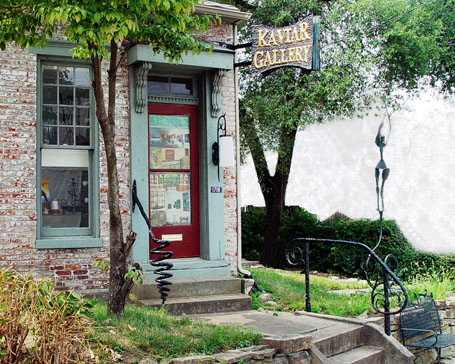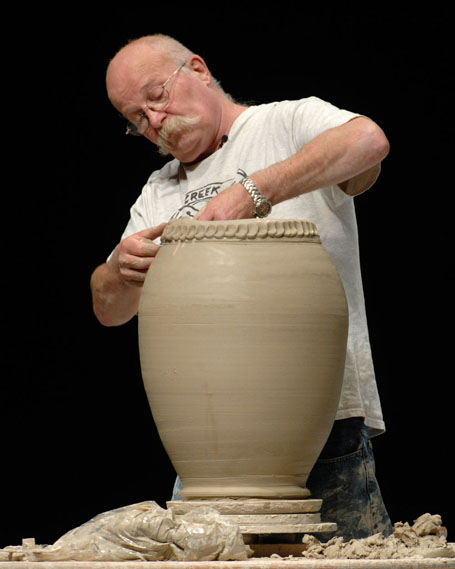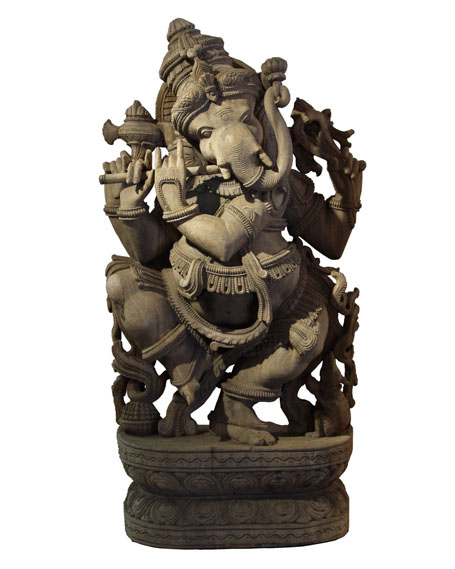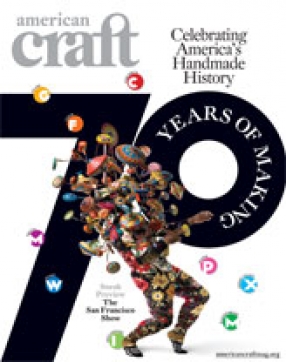

Photo/Ashley T. Evans, Western Carolina University

Photo/Anthony Scoggins.
Located in the southern Appalachian mountain region, Western Carolina University in Cullowhee, North Carolina, has made a specialty of celebrating the handwork of yesterday and today. In October it reunited the master ceramists Don Reitz and John Jessiman , old friends from the 1960s, for a workshop–Reitz’s first since his heart surgery two years ago. The event launched the university’s brand new Randall and Susan Parrott Ward Endowment Fund for Ceramics. Meanwhile, the school continues to develop its digital exhibit “Craft Revival: Shaping Western North Carolina Past and Present,” documenting a historic artisans’ movement (1895-1945) that still resonates today.
Each year the Corning Museum of Glass awards its coveted Rakow Commission to an up-and-coming artist for the creation of a new work for its collection. The latest is Host IX-Epidendrum, a delicate star orchid sculpted by the 2007 winner, Seattle-based Debora Moore. “There is a long and wonderful history of the making of flowers in glass, ranging from the glass rosettes of Bronze Age Mycenae to the late-19th-century botanical studies of the famous Bohemian craftsmen Leopold and Rudolf Blaschka,” says Tina Oldknow, curator of modern glass at Corning, adding that Moore’s piece “not only complements our historical pieces, but offers a new perspective on them.” Moore also does room-size installations suggesting primordial forests, though none of her complex plant studies are exact replicas: “It’s not my intention to be a realist. What I make is my own interpretation.”
The Textile Museum in Washington, DC, honored the philanthropist and connoisseur Lloyd Cotsen with its 2007 George Hewitt Myers Award for exceptional contributions to the field of textile arts. The former chairman and CEO of Neutrogena, Cotsen built a world-class collection of over 3,000 textiles and related objects during his 35 years with the company, and donated it to the Museum of International Folk Art in Santa Fe in 1995. His recent focus is a “Textile Traces” collection of some 5,000 small works, garments and fragments, thought to be one of the most important groups of historical textiles in private hands.
The woodworker Wendell Castle, a pioneer of the art furniture movement, received a Lifetime Achievement Award at a preview party November 15 for the 22nd annual “Mod-ernism: A Century of Style and Design” expo at the Park Avenue Armory in New York City. Designed to benefit the Brooklyn Museum, the evening also singled out ceramist Jonathan Adler (lead judge on TV’s Top _Design) with the Young Designer Award.
“Investing in America’s creative future” is the mission of United States Artists, a nonprofit organization formed in 2006, which recently made its second annual round of unrestricted grants to artists– $50,000 each to 50 recipients, including, in Crafts and Traditional Arts, totem pole carver Tommy Joseph, quilter Gwendolyn MaGee, electronic textile designer Maggie Orth, potter Virgil Ortiz, and sculptor/carver Susie Silook.
For its 30th anniversary, the Mingei International Museum in San Diego received an extraordinary gift: $500,000 from longtime benefactor Frances Hamilton White, who also pledged to match new donations up to an additional $500,000. The Mingei (Japanese for “art of the people”) presents folk art, craft and design from all periods and cultures at its two locations, in Balboa Park and Escondido.
Since 1985, metalworker Craig Kaviar has steadily transformed a rundown property in Louisville, Kentucky, into a unique studio and sculpture garden–an adaptive reuse that recently won him a historic preservation award. Now offering a retail space for crafts, Kaviar Forge and Gallery hosts “Flamenco at The Forge” on February 18. The visual/performing arts event benefits Ohio Valley Creative Energy, a project aimed at developing an innovative green building for “fire arts” (glass, metal, clay) powered by renewable fuels.
Therman Statom, known for his large glass sculptures and installations, and the Art Alliance for Contemporary Glass, an advocacy group, will be honored at the UrbanGlass gala auction and Glassblowers’ Ball April 4 in New York City.
“Without doubt, the most important figure in contemporary American knitting,” Jack Lenor Larsen once called Mary Walker Phillips, who took that traditional craft beyond pattern and utility to the level of high art. Phillips died November 3 at her home in Fresno, California, where she was born in 1928. Trained as a weaver at Cranbook Academy of Art, Phillips began to explore knitting in 1962. “I had only a few indications of its possibilities, but through experimentation, a whole new world opened up to me. Knitting became an art worthy of study. I was a weaver at the time and already had a love for yarn and for the designs created by the stitches, and I forsook the loom for the soft clicking of needles,” she wrote in her 1971 book, Creative Knitting: A New Art Form. Noted for their innovative structures and unexpected materials (leather, straw, glass), her hangings were exhibited worldwide. Phillips was named an American Craft Council Fellow in 1978.






Post Your Comment
Fields in bold are required. Your email address is required but not published. Please enter the five digit code as it appears in the text field on its right.